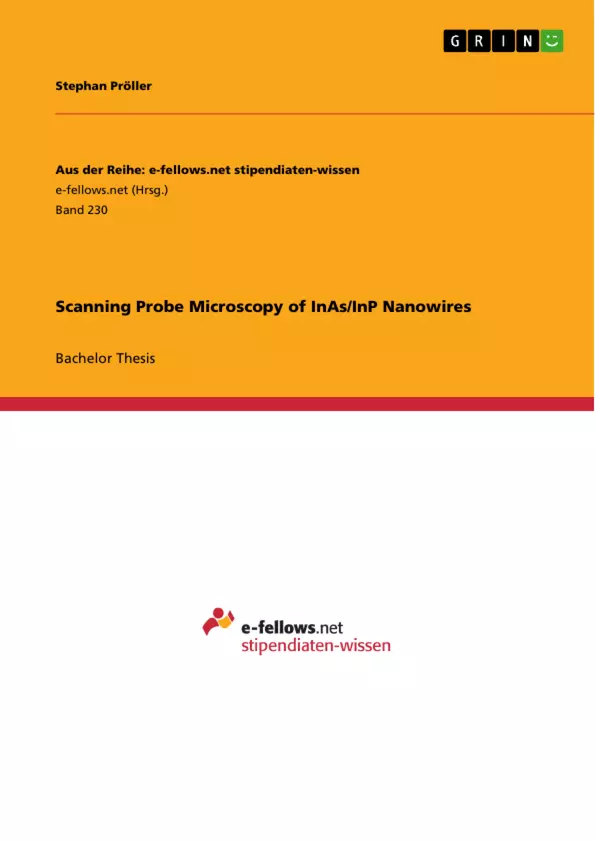In this thesis the InAs(111)B surface and III-V semiconductor nanowires are investigated using scanning tunneling microscopy and spectroscopy. The morphology of InAs nanowires grown without gold particle is studied. Radial nanowire heterostructure such as InP core with InAs shell are analyzed and the wurtzite top facet is identified. Furthermore nanowire heterostructures with an InP core and InAs shell with induced stacking faults possibly giving rise to quantum dots, which could be used as quantum dot lasers or for quantum information processing, are investigated. A model is obtained based on morphology analysis and as top facet the wurtzite and are found. Furthermore stacking faults on top of a nanowire are seen.
The analysis of the InAs(111)B surface shows the hexagonal pattern. Defects are determined to occur due to missing In atoms in the first layer. Spectroscopy next to those defects indicated no influence on the local electronic structure.
Inhaltsverzeichnis (Table of Contents)
- Abstract
- Sammanfattning
- Introduction
- Experimental Setup
- Results and Discussion
-
- InAs(111)B Surface
- InAs Nanowires Without Gold Particle
- InP Core with InAs Shell
- InP Core with InAs Shell and Stacking Faults
- Conclusion
- References
Zielsetzung und Themenschwerpunkte (Objectives and Key Themes)
This thesis aims to investigate the surface morphology and electronic properties of InAs(111)B and InAs/InP nanowires using scanning tunneling microscopy (STM) and spectroscopy (STS). The study focuses on the growth of InAs nanowires without gold particles, the analysis of radial nanowire heterostructures with InP core and InAs shell, and the investigation of stacking faults in these heterostructures. The research seeks to understand the morphology and electronic properties of these nanowires and their potential for applications in quantum dot lasers and quantum information processing.
- Morphology of InAs nanowires grown without gold particles
- Analysis of radial nanowire heterostructures with InP core and InAs shell
- Investigation of stacking faults in InP core with InAs shell nanowires
- Electronic properties of InAs(111)B surface and nanowires
- Potential applications of InAs/InP nanowires in quantum dot lasers and quantum information processing
Zusammenfassung der Kapitel (Chapter Summaries)
- The abstract provides a brief overview of the thesis, outlining the main topics and key findings. It highlights the investigation of InAs(111)B surface, InAs nanowires grown without gold particles, and InP core with InAs shell heterostructures.
- The Sammanfattning (Swedish summary) offers a concise overview of the thesis in Swedish, emphasizing the importance of semiconductor nanowires for future technologies and the potential applications of heterostructures with quantum dots.
- The introduction provides a comprehensive background on InAs and InP nanowires, their properties, and potential applications. It also outlines the motivation for this research and the specific objectives.
- The experimental setup chapter details the methods and equipment used in the study, including the STM and STS techniques.
- The results and discussion chapter presents the key findings of the study. It analyzes the morphology of InAs(111)B surface, the growth of InAs nanowires without gold particles, and the characterization of InP core with InAs shell heterostructures. It also explores the presence and impact of stacking faults on the electronic properties of the nanowires.
Schlüsselwörter (Keywords)
The main keywords and focus topics of the thesis include InAs/InP nanowires, scanning tunneling microscopy, scanning tunneling spectroscopy, heterostructures, stacking faults, quantum dots, quantum information processing, semiconductor materials, and nanotechnology. The research focuses on exploring the morphology and electronic properties of these nanowires for potential applications in quantum computing and optoelectronics.
- Citar trabajo
- Stephan Pröller (Autor), 2011, Scanning Probe Microscopy of InAs/InP Nanowires, Múnich, GRIN Verlag, https://www.grin.com/document/178801



